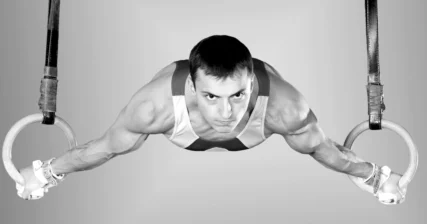Listen on: Apple Podcasts | Spotify
If there was only one type of exercise you could do, resistance training provides the most benefit for the time and effort you put into it. But where does a beginner…begin?
Most people don’t know where to start. And for those who do join a gym, only a small percentage of people know what to do when they get there. The rest resort to a workout program they followed in high school, or they find a row of equipment and do what looks easy. In essence, that’s like painting by numbers.
I launched VIGOR Training, my online fitness program in 2017. Since then, I’ve seen so many people transform themselves. The impact has been much greater than if I’d tried to train clients one at a time.
Yet, I feel like the impact pales in comparison to the potential. The other day, I had an epiphany.
Of those who’ve made significant transformations in VIGOR Training, the majority were members who followed VIGOR Strength Athlete or VIGOR Everyday Athlete. I designed both of these programs for men and women who have experience with strength training. They’re intermediate to advanced strength training programs.
However, I also offered Genesis (formerly Athlete In Training), my 3-month strength and conditioning program for beginners, all along. My epiphany was that few members in VIGOR Training were beginners. But if beginners didn’t “begin” strength training, how would the average person get stronger, leaner, and fitter?
That day, I decided to call a lot more attention to this program, and offer it for a ridiculously low price.
In this article, I’ll explain the principles behind a good beginner-level strength and conditioning program, which is what I based my Genesis programming around.
If you’d like to skip the reasoning behind the program, and just get started, tap the button in the box below.
Get the Genesis Strength and Conditioning Program For Only $49 per month
Genesis: noun, plural gen·e·ses [jen-uh-seez]. an origin, creation, or beginning.
This 12-week program is ideal for men and women in their mid-30s to mid-60s who’ve never strength trained consistently, or who have been out of the gym for years.
When you’re done with Genesis, you’ll be armed with the strength training knowledge and skills to take your fitness to a whole other level. You’ll gain strength, increase lean muscle mass, and and look and feel younger than most young adults!
Genesis Program Summary
- Program length: 12 weeks
- Skill level: Beginner
- Goals: Improved strength, mobility, and body composition
- Workout frequency: 4 days per week
Tap the button below and fill out the form to get started.
The Problems with Most Beginner-Level Workout Programs
It’s been over 20 years since I trained my first personal training client. I’ve learned a lot through experience, but even more through observation. Sadly, I’ve seen more people burn time, money, and effort on fitness programs that never bear fruit than those that deliver results. Often, those people work with personal trainers, which makes the situation even more sad.
If you sign up for and follow Genesis, you won’t have to worry about wasting your time. But, in the event you’re tempted to look at a different plan, program, or work with a professional, here are some things to be wary of.
1. Entertrainment isn’t the same as training
Can a workout be enjoyable? Sure. But if your first goal is to find something that’s fun, it probably won’t build muscle, bone density, and mobility while helping your heart, supporting your hormonal balance, strengthening your immune system, and making your metabolism more efficient.
As its name suggests, strength training trains your body to move and perform better, for longer, with less pain. A workout program that’s more about fun than developing fitness might help you pass the time, but it won’t get you the same level of results. And if you’re doing something to just pass the time, there’s probably something a lot more fun than a workout to do.
I bring this point up first because I’ve often heard people say, “I don’t enjoy strength training,” or “I really don’t like working out.” They often make these statements because they started exercising with a misguided notion of what the experience is all about.
I’d rather set the right expectation from the start (working out is “work”), rather than sell something that isn’t true (working out should be “fun”).
Training can be fun, but fun isn’t the focus of an effective, results-delivering, resistance training program for beginners.
2. Too much cardio and not enough resistance training
You might be tempted to hit the treadmill, stationary bike, or elliptical because you:
- Want to watch something on the TV or your smartphone (see point #1 – this isn’t about entertrainment)
- Know it’s easier to get on a piece of cardio equipment and just “go,” rather than trying how to learn how to strength train
- Believe that cardiovascular exercise is more important for long-term health than strength training is
I already addressed the “entertrainment” issue above.
Regarding the easiness of cardio over strength training, it’s easier to order a Big Mac and Fries than grill a steak and make a salad, but the Big Mac and Fries won’t serve you well in the long-term. Neither will an excessive focus on cardio, especially if you choose to do cardio in place of strength training.
Cardio won’t build muscle or bone density, doesn’t do much for mobility, and offers little hormonal benefit either. The health benefits from cardio pale in comparison to strength training.
3. Excessive focus on training intensity and not enough on technique
Just this past week, I witnessed a gym member doing walking lunges where she could barely get her back knee halfway to the floor as she lunged. Her personal trainer seemed oblivious to her client’s poor form, cheering her on to do more and more reps, all with the same awful form.
That’s like telling someone who has a Happy Gilmore golf swing to just swing harder. A big part of a beginner-level strength training program is relearning how to move properly.
It isn’t helpful to do lots of reps with terrible technique. You’re much better off doing fewer reps with impeccable technique. You’ll build strength faster, improve your mobility more, and significantly reduce the chance of being sidelined by an injury.
I keep the rep ranges on the low end for beginners, and constantly preach proper technique. Once you’ve gotten your technique down, you’ll be able to do higher reps and effectively use variations of those movements. But until you can kiss the floor with your back knee on a walking lunge you shouldn’t be doing dozens of reps, adding extra weight, or mixing a lunge with some other movement just because somebody once called it “functional training.”
4. Lack of Progression
“Change up your workout to keep your body guessing.” Each time I overhear a personal trainer offer such dumb advice to a client, I get the same feeling I get when I hear Joe Biden tell Americans the government can spend trillions of extra dollars and it won’t cost the people a dime.
Your body gets stronger through a principle called progressive overload. A training program needs to be designed in a way where you can measurably increase your physical output from one week to the next.
You create progressive overload by doing the same workouts from one week to the next, long enough that you can measurably make progress, and then make some changes to the routines before you plateau with your improvements.
However, most personal trainers have no plan with clients. Their clients show up and they come up with a random workout on the fly. Or, some people find a workout that looks fun on an app or website they found, and do that workout that day.
And then there’s one other common scenario in gyms…the members who show up and do the same exercises or classes they have for years, using the same level of resistance they did when they started.
You don’t create progressive overload through random workouts. You do so by following a professionally-designed program (like Genesis).
5. Expecting Your Workouts Will Offset Your Lifestyle
Deep down inside, you already know this. Yet, so many people still tell themselves that they can let loose with their diet because they worked out, or that they can spend the rest of their day on a chair or couch because they spent an hour at the gym.
Your workout is a stimulus to change. It tells your body to build muscle, get rid of some extra fat, get better at storing carbohydrates, and deal with higher levels of stress.
But that’s all it is…a stimulus.
It’s your diet and lifestyle that provide the environment and building blocks for your body to act on that stimulus.
Unfortunately, the health and fitness world has way-overcomplicated nutrition. As soon as you start talking about dietary changes, people get lost in rabbit holes about organic foods, whether dairy is good or bad, how many meals you should eat, what snacks are best, whether to choose high-protein or low-fat or low-carb, and dozens of other topics. They get overwhelmed, and so they don’t do anything.
I help guide you through the diet and lifestyle changes that offer the most health benefits for the smallest amount of physical and mental effort.
You do need to modify your nutrition and lifestyle, but it won’t be as complicated as you might think it will be.
Workout Terms Beginners Should Know
The following are common terms you’ll see in strength and conditioning programs, including Genesis.
Prep Work: “Warm-up” movements that improve joint range of motion or help to engage muscle groups important to the upcoming workout.
Time Under Tension: The time, in seconds, of each of the four parts of a movement, designated by four numbers (i.e. 2010).
- Eccentric: Moving with gravity, such as lowering your body on the squat
- Pause: The time between the eccentric and concentric movement
- Concentric: Moving against gravity
- Pause: The time between the concentric and eccentric movement
Sets: The number of times you perform a collection of repetitions.
Rest Period: The time you use to recover between sets or exercises.
Super Sets: When two exercises are paired together, and you perform a set of one exercise, rest, a set of the next exercise, rest, and then go back to the first exercise. Technically, the original way a superset was designed was to combine two exercises without rest between. However, for our purposes, they’re just paired movements.
Rate of Perceived Exertion: A subjective measure of intensity, measured on a scale of 1 to 10. 1 is watching someone workout while you lay on the couch. 10 is an all out intensity you could handle for up to 30 seconds.
Additional Tips for Those Who Start Genesis
If you’re a beginner, I hope you’ll join a gym and follow Genesis for the next six months. The following are a list of tips I recommend as part of the program.
- If you’re coming in cold, like first thing in the morning, take some extra time to walk on a treadmill or use an elliptical. It shouldn’t feel like a workout. This is just 5-10 minutes to get the blood flowing at a comfortable pace.
- Always avoid static stretching before a training session. It compromises muscle strength and power.
- Train in a fasted state. Coffee is great, assuming it’s black, but avoid calorie-containing food or supplements. I assume you’re not a high-level athlete reading this, as you wouldn’t be interested in a beginner workout program, if that was the case. You don’t need carbs, protein, or even amino acids before or during your training sessions, contrary to what someone at your local supplement store might sell you.
- Do the prep work! You might look at some of the prep exercises and think they’re not necessary. You might be tempted to jump right into the strength training. Don’t do that. The prep work helps you unwind some postural issues and muscle weaknesses caused by everyday life.
- Unless otherwise noted, maintain a tempo of about 2010. This should be a comfortable speed, where you’re always in control of the eccentric movement, but don’t have to put much thought into your tempo count. On something like back squats, your tempo will be closer to 3010 to 3020. Always in control of the bar, DBs or cable, but not rushed and not especially slow.
- Rest “as needed” between sets with rep targets of 6 or less. Rest 90-120 seconds between sets with rep targets of 6-15. Rest 60-90 seconds between sets with rep targets of 15+.
- Do 1-3 warm-up sets on the first movement of any major muscle group (back, chest, legs).
- Most training sessions should take an hour or less.
If You’re a Beginner, Begin!
I’d never promise someone that starting a beginner-level resistance training program will be easy, fun, or effortless. But if it’s a good program, none of that matters anyway. What does matter is how much stronger, healthier, and resilient you’ll be six months later.
Do the work and you’ll love the results. That’s much better than talking about doing the work and getting no results, or even worse, doing the work in a workout program that isn’t designed to get you results.
Get the Genesis Strength and Conditioning Program For Only $49 per month
Genesis: noun, plural gen·e·ses [jen-uh-seez]. an origin, creation, or beginning.
This 12-week program is ideal for men and women in their mid-30s to mid-60s who’ve never strength trained consistently, or who have been out of the gym for years.
When you’re done with Genesis, you’ll be armed with the strength training knowledge and skills to take your fitness to a whole other level. You’ll gain strength, increase lean muscle mass, and and look and feel younger than most young adults!
Genesis Program Summary
- Program length: 12 weeks
- Skill level: Beginner
- Goals: Improved strength, mobility, and body composition
- Workout frequency: 4 days per week
Tap the button below and fill out the form to get started.



